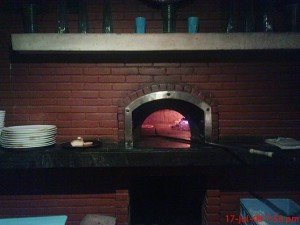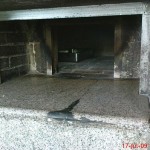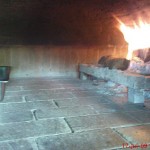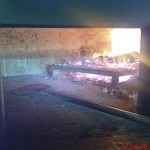Traditional Vs. Commercial for home and restaurants
 Hi, let me share something interesting you guys might want to consider when putting up a food establishment. I have been in the food industry for a decade and a half now and I have been so used to cooking with different types of ovens. I won’t claim to be an expert on this though I’m quite sure about the fact that it’s always best to go traditional!
Hi, let me share something interesting you guys might want to consider when putting up a food establishment. I have been in the food industry for a decade and a half now and I have been so used to cooking with different types of ovens. I won’t claim to be an expert on this though I’m quite sure about the fact that it’s always best to go traditional!
Currently, I’m operating five Italian Restaurants, two of which are powered by a standard 1.40 mtr. sized traditional brick oven and the rest with a typical commercial precast wood fired oven. It had been a challenge dealing with consistency issues since using substandard equipments. Though if there’s one thing I am sure of, it is that I achieve better food quality with my traditional oven.
 There are a number of factors I would regard as key to this claim, one is that I use less wood to fire up my traditional ovens and even lesser wood to maintain the temperature considering the same exhaust rate. I guess this could be attributable to the materials being used for the hearth and dome. I feel that a solid fire brick retains heat longer than ordinary refractory slabs typically used in commercial wood fired ovens. Aside from this, instead of using more bricks as insulation, contractors use sand as cheap alternative. This eliminates stability and heat retention properties as compared to using a more suitable material like fire bricks and clay. I’ve had the chance to see handcrafted brick ovens and I have got to tell you that these ovens do last a lifetime. Take for instance this brick oven servicing Shangri la Mactan, Cebu, which had been built 16 years ago.
There are a number of factors I would regard as key to this claim, one is that I use less wood to fire up my traditional ovens and even lesser wood to maintain the temperature considering the same exhaust rate. I guess this could be attributable to the materials being used for the hearth and dome. I feel that a solid fire brick retains heat longer than ordinary refractory slabs typically used in commercial wood fired ovens. Aside from this, instead of using more bricks as insulation, contractors use sand as cheap alternative. This eliminates stability and heat retention properties as compared to using a more suitable material like fire bricks and clay. I’ve had the chance to see handcrafted brick ovens and I have got to tell you that these ovens do last a lifetime. Take for instance this brick oven servicing Shangri la Mactan, Cebu, which had been built 16 years ago.  The only thing old about it was the antique look it had gained through accumulated years of service. Everything is still the way it was 16 years ago. I would even consider that as a positive remark since adding a homey and rustic feel to the already cozy ambiance of the resto. The traditional ovens I use are newly built though I would expect that they’d last a lifetime. The commercial ovens I have been using on the contrary are waiting to be refurbished. The floors are pitted and uneven. Some of the slabs had sunk probably due to the sand base that the contractor used. I have one that’s relatively new but just like the rest of them, floors are uneven and pitted, air and floor temperature does not get along most of the time and consumes firewood twice as much.
The only thing old about it was the antique look it had gained through accumulated years of service. Everything is still the way it was 16 years ago. I would even consider that as a positive remark since adding a homey and rustic feel to the already cozy ambiance of the resto. The traditional ovens I use are newly built though I would expect that they’d last a lifetime. The commercial ovens I have been using on the contrary are waiting to be refurbished. The floors are pitted and uneven. Some of the slabs had sunk probably due to the sand base that the contractor used. I have one that’s relatively new but just like the rest of them, floors are uneven and pitted, air and floor temperature does not get along most of the time and consumes firewood twice as much.
 If I would describe the quality of pizza my traditional oven brings out, I would have to say that it effectively bakes the crust giving it that distinct light and crisp finish it shows whenever I sum up the comments gathered from the guests. I have never achieved this with the commercial ovens I use. I would normally get what appears to be an overcooked pizza with a soggy crust, aside from the usual irregularly shaped crust that sticks to the floor resulting from an uneven air and floor temperature.
If I would describe the quality of pizza my traditional oven brings out, I would have to say that it effectively bakes the crust giving it that distinct light and crisp finish it shows whenever I sum up the comments gathered from the guests. I have never achieved this with the commercial ovens I use. I would normally get what appears to be an overcooked pizza with a soggy crust, aside from the usual irregularly shaped crust that sticks to the floor resulting from an uneven air and floor temperature.
 We nowadays, with all the technological advancements being made, tend to lean towards practicality and convenience as a means to achieve something that we forget the basics. Few realize the passion, beauty and simplicity of “artisan”. I was once like the rest of us, but having had stopped and smelt the flowers I came to realize that traditions should never be forgotten. Remember you roots! Ciao tutti!
We nowadays, with all the technological advancements being made, tend to lean towards practicality and convenience as a means to achieve something that we forget the basics. Few realize the passion, beauty and simplicity of “artisan”. I was once like the rest of us, but having had stopped and smelt the flowers I came to realize that traditions should never be forgotten. Remember you roots! Ciao tutti!
P.S. – I’ve been dreaming of soon being able to build myself the best brick oven in the Philippines. I have a couple of plans laid out already, but with your help I could build the best. Hoping for your most favorable reply.
Article for plans exchange.
Sincerely,
Mick Bondoc
Philippines
Respond to the Traditional Vs. Commercial for home and restaurants article:
8 Comments
Sorry, the comment form is closed at this time.
“I came to realize that many traditions should never be forgotten”. Wonderful statement. We need to take a step back every now and then and realize that some things we used to do should never be replaced.
By live green
I am really interested to have a brick oven in our little house. Who do you recommend to help me?
By Manny
Awesome brick ovens! There is no doubt that a commercial brick oven or wood fired oven is a beast choice for creating fabulously delicious pizzas. Although conventional commercial ovens are great for certain dishes nothing can compare to homemade pizzas baked fresh in wood fired ovens or other quality brick ovens with dense heat absorbing and retaining mass for that crispy baked just right pizza crust. Congrats on your success of owning 5 Italian resturaunts. As a resident in NY I have acquired a distinct taste for pizza and have found that pizzas made in brick oven beat baked pizzas in conventional ovens every time. Thank you for this enjoyable and useful information on the best ovens for business environments, it is very helpful information for business owners looking for a good oven or else as early hints to get started.
By Baxter Ovens
-Only a very few realize the passion, beauty and simplicity of “artisan” – this is sadly true. Great article. Ciao
By plin plin
Hey Mick,
If you’re in Manila, please let me know. Four of my kids just moved over there with their band – would I’m sure love to eat at one of your restaurants – who doesn’t love good Italian? And if you’ve got brick ovens – wow! My middle son, Vito is a barista from the SF Bay Area and loves to chat about coffee.
Thanks.
Waiting to hear…
Steve Tanton
Cazenovia, IL
By steve tanton
I have been thinking of making a traditional commercial oven. Having realized how much I spend on electric power. I do not use it for preparing a food though! : but for our traditional hair curling style. I spend 3 hours of electric power burning to get my finished product but sure there is a way to build a traditional oven for that heat source as a firewood is more available in the country than the power yet expensive. Please advise. Will be grateful.
Lawrence from Uganda
By Lawrence nsubuga
Rado,
Thank you for your quick response. I do have a couple questions. I am not questioning your designs, you have way more experience than I do at this, just trying to understand. When building the hearth, why do you place the insulated concrete slab down and then the concrete slab for the fire brick, instead of the other way around? Also when building the vault is it a bad thing to tie the vaults together with a running bond or does just not matter? And is a 32″x 36″ oven large enough to cook 2-3 pizzas at once? Thank you.
By Karsten
Karsten,
If the firebrick hearth (floor) has the dense slab underneath the firebricks, it means that the heat absorbing mass is bigger. The dense slab still retains heat therefore the floor holds the heat for much longer, remains hot longer due to the fact that more heat is held/retained in it. Thus the floor takes longer to cool down. The insulation below the dense layers protects the dense layers to rapidly loose the heat from under. So both the firebrick layer and the dense slab layer conduct the heat energy well and absorb and store well the heat energy. Good for baking, long time roasts and pizzas too.
The insulation under them is light-weight and works just the opposite, it doesn’t conduct nor store the heat.
If you only made pizzas while the ongoing fire/hot-red-embers are present while cooking, that would be a different story because the heat source is active at the time of cooking.
The MTo is 34 inches wide. How many pizzas do you intend to make say in 1 hour? No need for large oven to make 3 pizzas at a time, because pizza takes only 2 minutes to bake, and while one or 2 pizzas are inside baking, there is just a bout a time to prepare one pizza to be placed inside when another is done and taken out. How many pizzas can one oven operator prepare in 2 minutes, constantly, one only! No need for larger surface at all. If you are able to place in a pizza every 2 minutes, you would keep making 30 pizzas in an hour, which would be huge success at 15 bucks + per large quality pizza!
In my case, when it come to pizzas, I place one inside to cook and prepare another one pizza. I take the first pizza out on cutting board to cool down a little and straightaway I place the new-prepared pizza inside. I might at that stage prepare third pizza, and if I had the time I would cut in those 2 to 3 minutes the initial pizza as well. Basically the activity keeps going around and in 10-15 minutes the table gets full for a while. After a pause if it is needed I start preparing new pizzas, all stages the same way. Just different pizza styles.
Many ovens use cast iron or stainless steel metal supports in various places, it is only a structural matters, it cannot hurt to overengineer the oven structure while building it to make it more robust as that suits the oven character. Same for the extra thermal insulation around the dense cooking part, the more of it the better.
By Rado